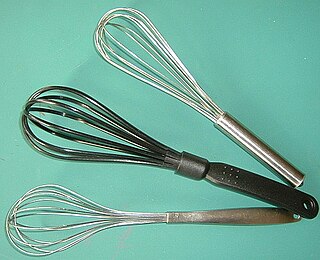Whisk
Whisk
Cooking utensil
A whisk is a cooking utensil which can be used to blend ingredients smooth or to incorporate air into a mixture, in a process known as whisking or whipping. Most whisks consist of a long, narrow handle with a series of wire loops joined at the end. The loops can have different shapes depending on a whisk's intended functions. The wires are usually metal, but some are plastic for use with nonstick cookware. Whisks are also made from bamboo.
This article needs additional citations for verification. (October 2013) |

Whisks are commonly used to whip egg whites into a firm foam to make meringue, or to whip cream into whipped cream.
The word whisk, given its similarity to equivalent words in modern Scandinavian languages, was probably borrowed from Old Norse.[1] It had early use in the Scots language as wisk and wysk.[2]
Bundles of twigs, typically apple, have long been used as whisks; often the wood used would lend a certain fragrance to the dish. An 18th-century Shaker recipe calls to "Cut a handful of peach twigs which are filled with sap at this season of the year. Clip the ends and bruise them and beat the cake batter with them. This will impart a delicate peach flavor to the cake."[3][4]
The bamboo whisk or chasen was invented in the late 15th century by Murata Jukō, who commissioned its production by Takayama Minbunojo Nyudo Sosetsu. Chasen were presented to Emperor Go-Tsuchimikado.[5][6] The process of producing chasen was kept secret and passed on by patrilineally by family craftsmen for hundreds of years.[7]
The wire whisk was invented sometime before 1841.[8]
In the United States, cranked rotary egg beaters became more popular than whisks in the 20th century. Julia Child is credited with re-introducing the wire whisk in her first ever televised appearance, in 1963.[9][10][11]
| Type | Description | Photo |
|---|---|---|
| Balloon whisk | The most common shape is that of a wide teardrop. Balloon whisks are best suited to mixing in bowls, as their curved edges conform to a bowl's concave sides. | |
| French whisk | With longer, narrower wire loops than a balloon whisk, the French whisk has a more cylindrical profile, suiting it to deep, straight-sided pans. | |
| Flat whisk / roux whisk | A flat whisk has the loops arranged in a flat successive pattern. It is useful for working in shallow vessels like skillets (in which a roux is normally prepared). | |
| Gravy whisk / spiral whisk | A gravy whisk commonly has one main loop with another wire coiled around it. The angle of the whisk head is ideal for mixing gravy, jello, batters and sauces. | |
| Twirl whisk / coil whisk | A twirl whisk has one single wire that is spiralled into a balloon shape. Designed to remain stationary in a bowl while the user pumps the handle up and down, it circulates liquids readily throughout a bowl. It is not suitable for whisking in the traditional sense, since dragging the whisk through a liquid or batter simply stretches out the coils, but is ideal for beating eggs. | |
| Ball whisk | Ball whisks have no loops whatsoever. Instead, a group of individual wires comes out of the handle, each tipped with a metal ball. The heavy balls are capable of reaching into the corners of a straight-sided pan. Since there are no crossing wires, the ball whisk is easier to clean than traditional looped varieties. Manufacturers of ball whisks also purport that their shape allows for better aeration. | |
| Chasen / bamboo whisk | A chasen is an integral part of Japanese tea ceremonies, used to stir or whip matcha into the desired consistency. | |
| Cage whisk / ball whisk | A cage whisk, sometimes also referred to as a ball whisk, is a balloon whisk with a small spherical cage trapped inside of it, which in turn holds a metal ball. |
Since the 19th century, various mechanical devices have been designed to make whisking more efficient, under the names "egg beater", "rotary mixer", etc.
- Mixer (cooking)
- Pastry blender
- fly-whisk: for brushing away flies
- "whisk, v.". Oxford English Dictionary (Online ed.). Oxford University Press. doi:10.1093/OED/4071942243. (Subscription or participating institution membership required.)
- "whisk, n.". Oxford English Dictionary (Online ed.). Oxford University Press. doi:10.1093/OED/9758221409. (Subscription or participating institution membership required.)
- Morse, Flo (1987). The Shakers and the World's People. UPNE. p. 51. ISBN 0874514266. Retrieved 15 August 2012.
- Miller, Amy Bess Williams; Persis Wellington Fuller (1970). The best of Shaker cooking. Macmillan. ISBN 0020098103.
- "The story of Japanese tea ceremony and Chasen (Tea whisk) has started in Nara I Voicecream Nara". Archived from the original on 2021-04-10. Retrieved 2021-04-10.
- See for example P. Masters, The Young Cook's Assistant and Housekeeper's Guide, London, 1841, pp. 222-3, 265
- Kennedy, Pagan (11 October 2012). "Who Made That Whisk?". The New York Times. Retrieved 20 September 2016.
- "A Julia Child lesson: The whisk". Associated Press. Retrieved 15 August 2012.